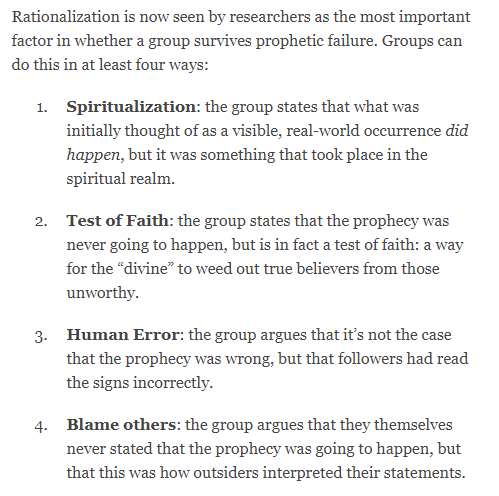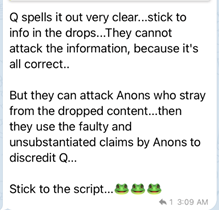1. There has been a lot of talk about QAnon and a well-known body of work in the sociology of religion/social psychology called the “failure of prophecy”.
A new piece by me and @_MAArgentino for @RDispatches, and a short thread: https://religiondispatches.org/qanons-predictions-havent-come-true-so-how-does-the-movement-survive-the-failure-of-prophecy/
A new piece by me and @_MAArgentino for @RDispatches, and a short thread: https://religiondispatches.org/qanons-predictions-havent-come-true-so-how-does-the-movement-survive-the-failure-of-prophecy/
2. As @travis_view noted, earlier this month there was anticipation in QAnon circles about the imminent return of JFK Jr. https://twitter.com/travis_view/status/1317474081034301443?s=20
3. He of course didn’t return. He’s very dead and has been dead for some time. It’s not the first time QAnon followers predicted something which never happened. And it won’t be the last:
4. Hillary Clinton has not been arrested, high profile elites have not been killed or sent to Guantanamo Bay, the hundred thousand sealed indictments were not released, and the promised Golden Age has not been delivered.
5. But, the group seems particular adept at surviving this “failure of prophecy”. What does the research around failure of prophecy tell us?
6. In their book "When Prophecy Fails, Festinger and colleagues provide readers with an account of a small religious group who they call “the Seekers”. The leader of this group, Marion Keech (a pseudonym), predicted the destruction of America in a great flood on Dec 21, 1955.
7. The Seekers, though, would be saved from destruction by aliens who were communicating with Keech telepathically. As Dec 21 came and went with no spacecraft, many of the members sat in disbelief. Then Keech received a message from the aliens: the apocalypse had been called off.
8. As Festinger and colleagues write, “This little group, sitting all night long, has spread so much goodness and light that the God of the Universe spared the Earth from destruction.”
9. This final "message" was brilliant. The final message communicated to Keech convinced the Seekers that all their work was not in vain; rather, it was precisely their preparations and commitment that saved humankind from cataclysm.
10. From this case study of the Seekers, Festinger developed what he called the "theory of cognitive dissonance."
Put simply, the theory asserts that people are uncomfortable holding inconsistent beliefs and ideas at the same time and are driven to reduce this discomfort.
Put simply, the theory asserts that people are uncomfortable holding inconsistent beliefs and ideas at the same time and are driven to reduce this discomfort.
11. One thing the Seekers did after Dec 21 was something counter-intuitive: they began to proselytize. Once the initial cognitive dissonance had been reduced by the idea that their actions had saved the world, they sought to solidify this view by seeking validation from others.
12. For Festinger and his colleagues, proselytization was the key move that followers engaged in to reduce cognitive dissonance, but research over the last 50 years has added many more factors. Read the piece, where we go into detail about all the different strategies involved.
13. So, what did QAnon followers do when JFK didn’t come back? One of the main strategies they used was to argue that some followers had gone off the path of truth.
14. Adherents argued that some followers had strayed from the path of truth and were now dabbling in ideas that were hurting the cause. This argument was used to rally the true believers and reaffirm their commitment to the Q and the “authentic” Qdrops. A sample:
15. This is what QAnon adherents perceive as gospel and as indisputable and built upon three years of “evidence”.
The sophistication and diversity of the QAnon ideology also means that some aspects of the worldview can be disproved while the movement continues.
The sophistication and diversity of the QAnon ideology also means that some aspects of the worldview can be disproved while the movement continues.
16/16. Many of the strategies outlined in the research literature over the last several decades are important for understanding how QAnon will react to future events – including the potential loss of Trump in the election, which could be the biggest failure of prophecy of all.

 Read on Twitter
Read on Twitter



